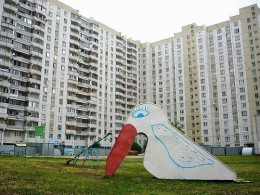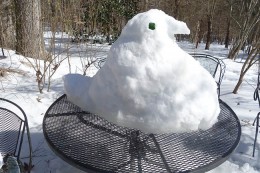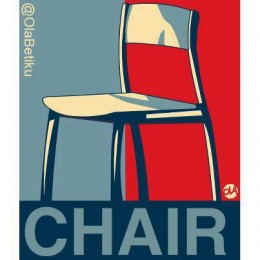http://www.walkerart.org/magazine/2013/painter-painter-reframing-medium
Walker Art Center
Painter Painter: Reframing a Medium
By Julie Caniglia
The Walker’s first survey of contemporary painting in 12 years, Painter Painter explores new directions in abstraction in the work of 15 emerging artists from the United States and Europe. While deeply invested in studio practice and in developing their own personal modes of making, the artists also approach abstraction as a means to engage with the world. Through online writings, a series of lectures and events, and the exhibition itself, Painter Painter offers a unique snapshot of the evolving role of painting today. Walker staff writer Julie Caniglia recently discussed the exhibition with co-curators Eric Crosby and Bartholomew Ryan.
Julie Caniglia
What makes this an opportune time for a show on contemporary painting, and how did the two of you make this not just another show about this topic?
Eric Crosby
There has been so much attention paid to abstract painting recently, but few museums have attempted to take that on. It’s easy to select a group of new paintings and say that this is the next chapter in the history of the medium, like we’re expected to write a new afterword to the history we’ve all inherited. But that way of thinking feels contrived right now and disconnected from the way artists are working.
So we set out to make a show based on our shared interest in painting and some questions about abstraction in particular. And we knew we would focus on the present, of course, not only in terms of new artistic practices but also how we imagined our work as curators. The idea was to follow our instincts and see where the process would take us.
That’s why regular studio visits became such a key part of our process. The more modest scale of the show helped with that. Painting at the Edge of the World, the Walker’s last group painting show in 2001, featured some 30 artists and had a more global reach and historical scope. Our parameters allowed us to create a different kind of exhibition, one that could emerge organically from conversations and relationships that developed in artists’ studios—which became more important than the typical relationship between a curator and artworks on a checklist. The artists’ enthusiasm about the medium really guided key decisions about the show.
Bartholomew Ryan
From the beginning we wanted to go into the conversation without making too many presuppositions. Painting has always been a somewhat fraught medium, and particularly so over the last 30 to 40 years. Both Eric and I avoided bringing the more trenchant dogmas associated with it into our conversations with the artists. We wanted to be more attentive to the work on its own terms and try to figure things out from there. So our earliest questions were really simple, for instance: why choose the materials of painting today, at a time when artists can work in so many other ways?
We were also interested in a question related to some of the work being made now, which one often hears from older generations of curators, historians, and even artists, which is “Where is the criticality?” There is a certain expectation today that if a painter is to continue as a painter, there has to be some basic level of self-reflexivity, some wry acknowledgment of the problematic status of continuing to paint in a postmodern era, when painting itself has been toppled from its lofty perch. I think that’s been a good thing up to a point, but it has become deadening and knee-jerk. Many of the artists in our show have consciously sidestepped that way of framing their work, and they find more interesting things to think about.
Caniglia
So if painting itself is a fraught medium, as you said, what does that mean for abstract painting? And what does abstraction mean to these artists?
Ryan
While we are talking about very different individuals with very different ways of working, for them the idea of abstraction isn’t writ as large as it once was. While abstraction with a capital A carries with it a series of strong historical references, the conversation today is not simply art-historical. Abstract painting can and does allude to a lot of other visual cultures, styles, and contexts, and the artists, of course, are aware of this. I think they prefer that their work hovers in some area where it can’t quite be located, but still invites viewers to make their own associations. The work is less about abstraction than being open to the world and not wanting to lock things into a defined moment of meaning.
Crosby
One way the thinking about abstraction has evolved is that it isn’t necessarily a condition of the image, but rather the result of context. In organizing this show, we’ve come to know these artists as creating possibilities for painting both in and out of studio. Inside, they’re pursuing all these new methods of formal invention and new techniques. Often they’re working with what’s at hand or what the medium gives them. In this sense, while their images or creations may take on the appearance of abstraction, what happens in the studio is very real, particularly in a material sense. So the way I see it, abstraction sets in when the work leaves the studio. Circulating out there in the world, creating networks with other images—that’s when this very real thing hanging on the wall in front of you develops a second life.
Caniglia
You’ve both said that this is an exciting time for painting, and described a spirit of reinvention in the field right now. Can you talk about where that’s coming from?
Ryan
One thing that’s opened up a lot of possibilities is changes in how we look at art history today. More specifically, it’s the way these painters tend to resist the hierarchies of the past in their interpretation of the medium. For instance, Molly Zuckerman-Hartung and Dana DiGiulio made a list a few years ago called “Painters you should know,” with well over 100 names that span centuries. At other times, these painters would have been pitted against each other, with people ?siding with some over others. But to Molly they’re all part of the conversation. That’s partly due to the Internet, which has created the opportunity to be inclusive and, of course, exclusive, and to let us explore a topic on our own terms. So in looking at how these artists relate to painting and its history, it’s not a matter of making either/or choices—it’s a both/and situation. And maybe it’s because of that lack of limits that there is, on the other hand, this desire to work with a medium that does have limits, as painting does—but to see the potential or the possibilities within those limits. This finding freedom in restrictions is almost necessary in a world with so much access to everything. And as a strategy, it is something every artist today needs to contend with.
Crosby
There’s also something about the resolute materiality of painting that continues to attract artists. These are objects that follow deeply subjective and individual ways of thinking, as expressed through specific materials. In this show you will see works that are stained, collaged, sprayed, cut up, stitched, assembled, glued, smeared, rubbed, and so on— some works are years in the making. Painting offers a frame for contact with this very physical presence. It’s a vivid contrast with our daily routine, where we experience so many images by using a cursor, linking to them, altering them, navigating away from them. Painting resists this kind of experience. A lot of artists today embrace that notion to an extreme. They go where the materials take them, not where the history of painting tells them to go. I think that’s why the more we talked with artists in the show, the more sense it made for them to create new work specifically for this occasion. We saw that as giving the show a sense of timeliness and presence, even if it does mean relinquishing some of our control in the process.
Ryan
It’s not about our playing a perfect hand as curators, working from a predefined checklist, but about creating an exhibition as a continuation of the conversation with the artists—and hopefully imparting some of that quality to the people who come to see the show.
Crosby
Besides, it’s more fun to leave it open-ended.
The exhibition Painter Painter is on view February 2–October 27, 2013.
————————————————————————————————-COMMENTS:
Mike Hoyt • Works at Pillsbury United Communities
i’m just glad painting is important again so we can come out of hiding… At least until it is once again labeled dead. • 2 • February 6, 2013 at 1:58pm
Gudrun Mertes-Frady • Brooklyn, New York
“…if a painter is to continue as a painter, there has to be some basic level of self-reflexivity, some wry acknowledgment of the problematic status of continuing to paint in a postmodern era, when painting itself has been toppled from its lofty perch.”
If you are a painter, color and paint is your medium of expression, like words are for writers and poets, you would not tell writers that all the poems and novels have been written, same is true for music. Why is painting always declared dead time and time again over the last decades? I believe painters have this insane trust that something with a “reason être” will emerge on the forbidding white wall in front of them and it always has and forever will. Historians sort things out looking backwards, explaining the connections, an important position. But they don’t have the imagination to look forward, but artists do. • 7 • February 3, 2013 at 11:55am
Michael Cross
Some people regard painters as just “image makers”. And that point of view caused them to declare painting obsolete when for instance photography was invented, or computer imaging became possible. But those who understand painting as a multi-sensory experience necessary to the painter, not only a visual experience for the viewer, can also understand the medium’s survival and vitality.• 3 • February 3, 2013 at 12:24pm
Mike Arar • Split, Croatia
To most of the world,painting has always been dead.It can not be compared to literature or music,people are passionate about those two,because they can,buy it,feel it ,hear it anywhere.Hangerson,like journalists and critics are largely ignored,people make up their own mind.The entourage of vultures surrounding painting is huge compared with the music and literature industry and their impact is enormous.So many opinion makers so little to write about.Lets say it’s dead! But it’s not. Many new young artist use graffiti to express them self.I love it. • February 13, 2013 at 9:09am
Nina Allen • University of Minnesota – Twin Cities
These works are of self-reflection and working with mediums. As a painter I had strong connections to Alex Olson’s and Sarah Crowner’s works. I work through the process and look to pull in other arts in to my work too. I found Sarah Crowner’s canvas stitched together extremely powerful. It was exciting to have the opportunity to see the work in person. The pictures can not capture the work on display. I recommend that if you have an opportunity to attend Painter Painter, to do so. I think many of the artist were inspired by Robert Rauschenberg. • 2 • February 17, 2013 at 6:30pm







































